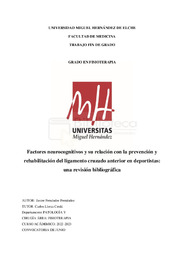Por favor, use este identificador para citar o enlazar este ítem:
https://hdl.handle.net/11000/30348Registro completo de metadatos
| Campo DC | Valor | Lengua/Idioma |
|---|---|---|
| dc.contributor.advisor | Llorca Cerdá, Carlos | - |
| dc.contributor.author | Fernández Fernández, Javier | - |
| dc.contributor.other | Departamentos de la UMH::Patología y Cirugía | es_ES |
| dc.date.accessioned | 2023-12-12T10:11:13Z | - |
| dc.date.available | 2023-12-12T10:11:13Z | - |
| dc.date.created | 2023-06-16 | - |
| dc.identifier.uri | https://hdl.handle.net/11000/30348 | - |
| dc.description.abstract | Introducción: el ligamento cruzado anterior (LCA) es una estructura intraarticular que evita la translación anterior de la tibia sobre el fémur y preserva el movimiento biomecánico normal de la rodilla. El mecanismo lesional más común del LCA es el indirecto, ocurriendo durante movimientos de deceleración, cortes o aterrizajes desde un salto. Un rendimiento cognitivo deficiente y alteraciones sensoriomotoras se asocian con un mayor riesgo de lesiones de LCA. El tratamiento y la rehabilitación son procesos prolongados y la atención a los factores neurocognitivos y sensoriomotores es crucial. Objetivos: investigar la influencia de los factores neurocognitivos en la rehabilitación y el rendimiento funcional en deportistas sobre el LCA, identificando las estrategias de intervención para mejorar la recuperación y el medio para evaluar las áreas que se activan a la hora de combinar una tarea con un abordaje neurocognitivo. Material y métodos: búsqueda a través de diferentes bases de datos: Pubmed, Science direct, scopus, PEDro, incluyendo un total de 8 artículos a partir de 2013. Resultados: 8 artículos en total. Cuatro, evaluaban el análisis de la resonancia magnética mientras se realizaban tareas. Los restantes, evaluaron el control neuromuscular, rendimiento funcional y factores como la kineosofobia. Conclusiones: evidencia de la influencia de los factores neurocognitivos en la activación muscular, las áreas motoras implicadas y el rendimiento funcional al realizar las tareas, teniendo en cuenta la kinesofobia. Se comprueba que la FMRI es efectiva en la sobreexcitación de las áreas cerebrales, evidenciando los cambios sensoriomotores. | es_ES |
| dc.description.abstract | Introduction: the anterior cruciate ligament (ACL) is an intra-articular structure that prevents anterior translation of the tibia over the femur and preserves normal biomechanical motion of the knee. Indirect ACL injury is the most common one, occurring during deceleration movements, cuts or landings from a jump. Poor cognitive performance and sensorimotor impairment are associated with an increased risk of ACL injury. Treatment and rehabilitation are lengthy processes and attention to neurocognitive and sensorimotor factors is crucial. Objectives: to investigate the influence of neurocognitive factors on rehabilitation and functional performance in athletes on the ACL, identifying intervention strategies to improve recovery and the means to evaluate with a neurocognitive approach the areas that are activated when performing a multiple task. Material and methods: search through different databases: Pubmed, Science direct, scopus, PEDro, including a total of 8 articles from 2013. Results: 8 articles in total. Four of them evaluated MRI analysis while performing tasks. The remaining evaluated neuromuscular control, functional performance and factors such as kinesiophobia. Conclusions: evidence of the influence of neurocognitive factors on muscle activation, motor areas involved and functional performance when executing the tasks, considering kinesophobia. It is proved that FMRI is effective in the overexcitation of brain areas, evidencing sensorimotor changes. | es_ES |
| dc.format | application/pdf | es_ES |
| dc.format.extent | 36 | es_ES |
| dc.language.iso | spa | es_ES |
| dc.publisher | Universidad Miguel Hernández de Elche | es_ES |
| dc.rights | info:eu-repo/semantics/openAccess | es_ES |
| dc.rights.uri | http://creativecommons.org/licenses/by-nc-nd/4.0/ | * |
| dc.subject | LCA | es_ES |
| dc.subject | rehabilitación | es_ES |
| dc.subject | volver al deporte | es_ES |
| dc.subject | plasticidad cerebral | es_ES |
| dc.subject | cognitivo | es_ES |
| dc.subject.other | CDU::6 - Ciencias aplicadas | es_ES |
| dc.title | Factores neurocognitivos y su relación con la prevención y rehabilitación del ligamento cruzado anterior en deportistas: una revisión bibliográfica | es_ES |
| dc.type | info:eu-repo/semantics/bachelorThesis | es_ES |

Ver/Abrir:
TFG_Javier_Fernandez_Fernandez..pdf
896,9 kB
Adobe PDF
Compartir:
 La licencia se describe como: Atribución-NonComercial-NoDerivada 4.0 Internacional.
La licencia se describe como: Atribución-NonComercial-NoDerivada 4.0 Internacional.
.png)